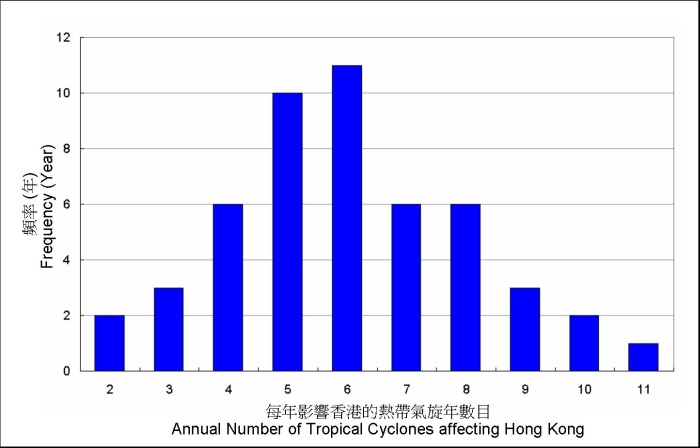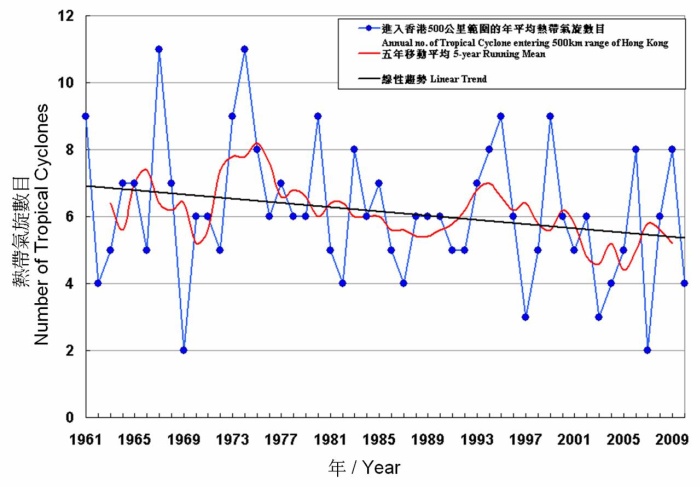Typhoon 5-6
3 April 2012
This blog title may sound a bit peculiar to many people. "5-6" is certainly not a new name of tropical cyclone in the western North Pacific. In fact, 5 and 6 are the two most frequently occurred numbers of tropical cyclones affecting Hong Kong[Note] each year, based on the statistics in the past five decades (See Figure 1).

Figure 1Frequency distribution of annual number of tropical cyclones affecting Hong Kong from 1961 to 2010.
The tropical cyclone records in Hong Kong reveal that there were very large inter-annual and inter-decadal fluctuations in the annual number of tropical cyclones affecting Hong Kong. The lowest record is two in a year (in 1997 and 2007) while the highest record is 11 (in 1974). The average numbers of tropical cyclones for various periods are given in Table 1. While all the averages shown fall well within the range between 5 and 7, the 30-year average decreases from the 6 to 7 for the 30 year periods of 1961-1990 and 1971-2000 to between 5 and 6 for 1981-2010. The long term 50-year average from 1961 to 2010 is about 6.

Table 1Average number of tropical cyclone crossing within 500km of Hong Kong and
average number of tropical cyclone signals for different periods.
The decrease in the 30-year averages in the last few decades is an interesting subject to look into. The inter-annual and inter-decadal variations in tropical cyclone frequency in the western North Pacific are likely related to a number of factors which affect the sea surface temperature and atmospheric circulations in the region. These factors include the El Niño and La Niña as well as the Pacific Decadal Oscillation[1-2] which may have effects for periods of several years to decades. Moreover, some recent research suggested that the long term sea surface temperature rise due to human-induced climate change[3] could also affect the tropical cyclone frequency, intensity and movement. Since the causes of the variations in the tropical cyclone frequency in the western North Pacific and the South China Sea are rather complex and may comprise both natural and human-induced influences, more studies are still required to further understand the relative contributions of natural variations (e.g. El Niño and La Niña) and human-induced factors to the past and future changes in tropical cyclone activity in the region.

Figure 2Annual number of tropical cyclones (including tropical depressions) crossing
within 500 km of Hong Kong during 1961 to 2010.
In view of the presence of significant inter-decadal or even multi-decadal fluctuations in tropical cyclone activity in our region, the 30-year average of tropical cyclone counts may exhibit noticeable changes from one period to the other. Therefore, in depicting the norm for the annual number of tropical cyclone affecting Hong Kong, it may be more appropriate to refer to the long term average of 1961-2010 which is about 6 in a year.
T C Lee & Y Y Cheng
Note : Refer to tropical cyclones crossing within 500km of Hong Kong (22.3o N, 114.17o E). The use of 500 km range as a proxy indicator of tropical cyclones affecting Hong Kong is because the average number of tropical cyclones entering this range (about 6) is roughly the same as the long-term average of the annual number necessitating the issuance of local tropical cyclone warning signals in Hong Kong.
References:
[1] El Niño and La Niña http://www.hko.gov.hk/lrf/enso/enso-front.htm
[2] Pacific Decadal Oscillation http://www.hko.gov.hk/climate_change/pdo_e.htm
[3] Climate Change Webpage http://www.hko.gov.hk/climate_change/climate_change_e.htm

Figure 1Frequency distribution of annual number of tropical cyclones affecting Hong Kong from 1961 to 2010.
The tropical cyclone records in Hong Kong reveal that there were very large inter-annual and inter-decadal fluctuations in the annual number of tropical cyclones affecting Hong Kong. The lowest record is two in a year (in 1997 and 2007) while the highest record is 11 (in 1974). The average numbers of tropical cyclones for various periods are given in Table 1. While all the averages shown fall well within the range between 5 and 7, the 30-year average decreases from the 6 to 7 for the 30 year periods of 1961-1990 and 1971-2000 to between 5 and 6 for 1981-2010. The long term 50-year average from 1961 to 2010 is about 6.

Table 1Average number of tropical cyclone crossing within 500km of Hong Kong and
average number of tropical cyclone signals for different periods.
The decrease in the 30-year averages in the last few decades is an interesting subject to look into. The inter-annual and inter-decadal variations in tropical cyclone frequency in the western North Pacific are likely related to a number of factors which affect the sea surface temperature and atmospheric circulations in the region. These factors include the El Niño and La Niña as well as the Pacific Decadal Oscillation[1-2] which may have effects for periods of several years to decades. Moreover, some recent research suggested that the long term sea surface temperature rise due to human-induced climate change[3] could also affect the tropical cyclone frequency, intensity and movement. Since the causes of the variations in the tropical cyclone frequency in the western North Pacific and the South China Sea are rather complex and may comprise both natural and human-induced influences, more studies are still required to further understand the relative contributions of natural variations (e.g. El Niño and La Niña) and human-induced factors to the past and future changes in tropical cyclone activity in the region.

Figure 2Annual number of tropical cyclones (including tropical depressions) crossing
within 500 km of Hong Kong during 1961 to 2010.
In view of the presence of significant inter-decadal or even multi-decadal fluctuations in tropical cyclone activity in our region, the 30-year average of tropical cyclone counts may exhibit noticeable changes from one period to the other. Therefore, in depicting the norm for the annual number of tropical cyclone affecting Hong Kong, it may be more appropriate to refer to the long term average of 1961-2010 which is about 6 in a year.
T C Lee & Y Y Cheng
Note : Refer to tropical cyclones crossing within 500km of Hong Kong (22.3o N, 114.17o E). The use of 500 km range as a proxy indicator of tropical cyclones affecting Hong Kong is because the average number of tropical cyclones entering this range (about 6) is roughly the same as the long-term average of the annual number necessitating the issuance of local tropical cyclone warning signals in Hong Kong.
References:
[1] El Niño and La Niña http://www.hko.gov.hk/lrf/enso/enso-front.htm
[2] Pacific Decadal Oscillation http://www.hko.gov.hk/climate_change/pdo_e.htm
[3] Climate Change Webpage http://www.hko.gov.hk/climate_change/climate_change_e.htm